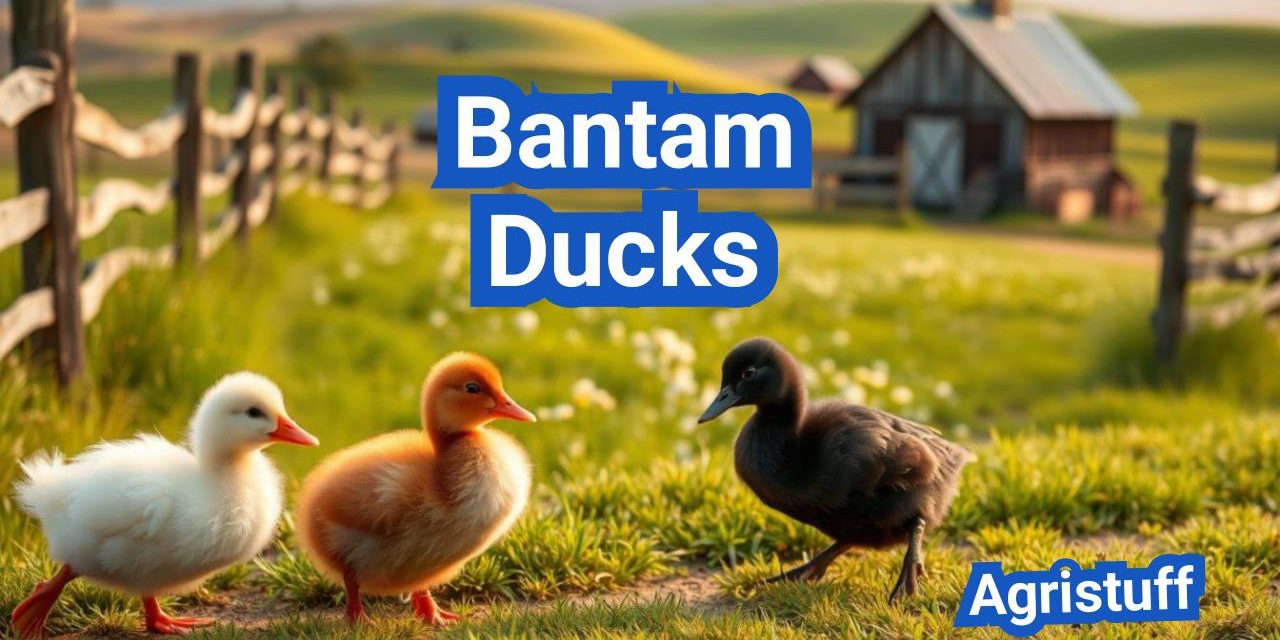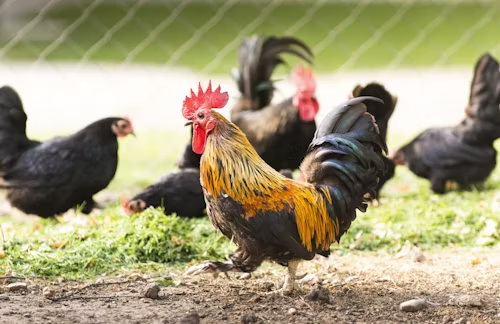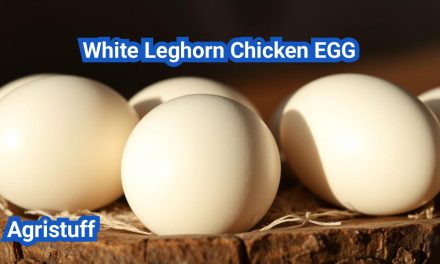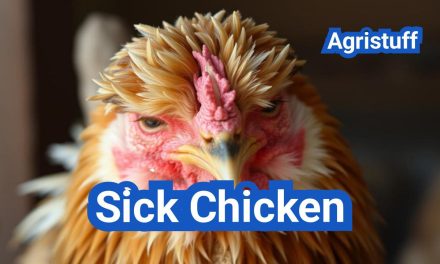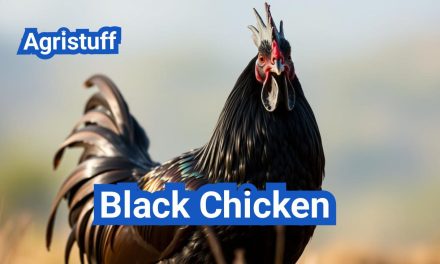Raising bantam ducks has become a popular hobby among backyard farmers and animal enthusiasts. These small duck breeds are not only adorable but also relatively easy to care for, making them an ideal choice for those new to backyard ducks.
The charm of bantam ducks lies in their compact size and friendly nature. They require less space and food compared to larger duck breeds, making them a practical choice for small farms or residential areas. With proper duck care, bantam ducks can thrive and become a delightful addition to any backyard.
Key Takeaways
- Discover the benefits of raising bantam ducks in your backyard.
- Learn about the unique characteristics of small duck breeds.
- Understand the basics of duck care for a healthy flock.
- Explore the advantages of bantam duck breeds for small farms.
- Get started with raising bantam ducks with confidence.
What Are Bantam Ducks?
As a smaller alternative to regular ducks, bantam ducks have gained popularity among backyard poultry keepers. These diminutive ducks offer a unique combination of charm, functionality, and ease of care, making them an attractive choice for many enthusiasts.
Definition and Historical Background
Bantam ducks are a type of domestic duck that has been bred in various colors and is known for their friendly disposition. The term “bantam” refers to the smaller size of these ducks compared to standard breeds. Historically, bantam ducks have been developed from larger duck breeds through selective breeding practices aimed at reducing their size while retaining desirable traits.
The origins of bantam ducks can be traced back to various parts of the world, including Asia and Europe, where they were bred for their unique characteristics and ornamental value. Over time, bantam ducks have become popular not only for their aesthetic appeal but also for their egg-laying abilities and friendly nature.
Bantam Ducks vs. Regular Ducks: Key Differences
When comparing bantam ducks to regular ducks, several key differences become apparent. The most obvious distinction is their size; bantam ducks are significantly smaller than their standard counterparts. This size difference has several implications for backyard poultry keepers.
- Space Requirements: Bantam ducks require less space, making them ideal for smaller backyards or urban settings.
- Feed Consumption: Due to their smaller size, bantam ducks consume less feed, which can be a cost-effective advantage.
- Egg Production: While bantam ducks lay smaller eggs, they can still provide a steady supply of eggs, albeit fewer in number compared to larger breeds.
- Temperament: Bantam ducks are often known for their friendly and social nature, making them a joy to keep.
Understanding these differences is crucial for individuals considering adding ducks to their backyard flock. By choosing bantam ducks, keepers can enjoy the benefits of duck keeping even in more confined spaces.
Popular Bantam Duck Breeds for Beginners

Starting your duck-keeping adventure with bantam breeds can be a rewarding experience, thanks to their friendly and adaptable nature. Bantam ducks are smaller, more manageable versions of regular ducks, making them perfect for those with limited space or those who are new to raising poultry.
Call Ducks: The Classic Bantam
Call ducks are one of the most recognizable bantam breeds, known for their tiny size and distinctive quacking calls. They are friendly, social birds that thrive on interaction and are relatively low maintenance. Their small size makes them ideal for small backyards or even indoor keeping, provided you have the right setup.
Black East Indie Ducks
Black East Indie ducks are another popular bantam breed, admired for their sleek, dark plumage and foraging abilities. They are active, hardy birds that can adapt to various environments. Their ability to forage makes them a great choice for those interested in more self-sufficient poultry keeping.
Miniature Silver Appleyard Ducks
Miniature Silver Appleyard ducks are a favorite among many duck enthusiasts due to their friendly disposition and prolific egg-laying abilities. They are relatively quiet, making them suitable for urban or suburban settings. Their striking silver-gray and white plumage adds to their appeal, making them a beautiful addition to any backyard flock.
Bantam Pekin and Buff Pekins
Bantam Pekin and Buff Pekin ducks are miniature versions of the popular Pekin duck breed, known for their white or buff-colored plumage and friendly, docile nature. They are easy to handle and care for, making them an excellent choice for beginners. Their calm demeanor also makes them a good choice for families with children.
More Specialized Bantam Duck Varieties
For those looking to diversify their backyard flock, several specialized bantam duck breeds offer unique characteristics and charm. These breeds not only add variety to a duck collection but also provide enthusiasts with the opportunity to raise ducks that stand out due to their distinct features.
Bantam Mallards and Their Characteristics
Bantam Mallards are a popular choice among duck enthusiasts due to their vibrant colors and energetic personalities. Unlike their larger counterparts, Bantam Mallards retain the classic Mallard appearance in a compact form, making them an attractive addition to any flock. Their bright plumage and active nature make them a delight to watch.
Bantam Saxony Ducks
Bantam Saxony Ducks are known for their beautiful coloration and friendly disposition. Originating from the larger Saxony breed, these bantams inherit the same rich, multi-tonal plumage that makes them stand out. They are relatively easy to care for, making them suitable for both beginners and experienced duck keepers.
Bantam Silkie Ducks: The Unusual Breed
Bantam Silkie Ducks are perhaps one of the most unique breeds due to their fluffy, silk-like feathers. This characteristic gives them a soft, endearing appearance that many find irresistible. Despite their unusual looks, Bantam Silkies are known for their friendly and outgoing personalities, making them a great choice for those looking for a pet duck.
Lemon Pekins and Other Rare Varieties
Lemon Pekins are another rare and charming breed that has gained popularity among enthusiasts. Their light, citrus-colored plumage sets them apart from other Pekin varieties. Other rare bantam duck breeds worth mentioning include various color mutations and heritage breeds that, while less common, offer a unique appeal to collectors and hobbyists.
Physical Characteristics of Bantam Ducks
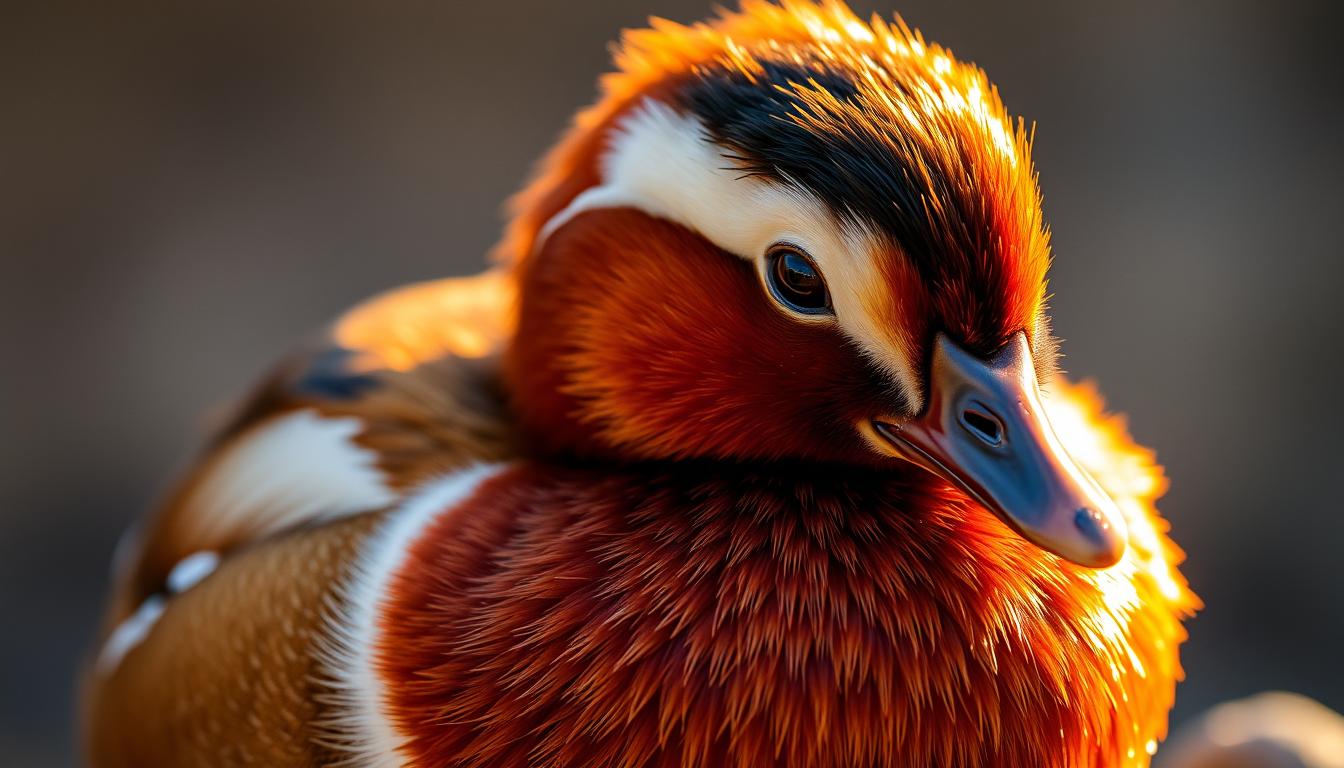
Bantam ducks exhibit a range of physical characteristics that set them apart from larger duck breeds. Their compact size, varied coloration, and relatively long lifespan make them an attractive choice for many duck keepers.
Size and Weight Expectations
Bantam ducks are significantly smaller than standard ducks, with most weighing between 1 and 2 pounds (0.5 to 1 kg). Their compact size makes them ideal for small backyards or homesteads with limited space.
The average weight of bantam ducks can vary depending on the breed. For example, bantam Call ducks typically weigh around 1 pound (0.5 kg), while bantam Pekin ducks can weigh up to 2 pounds (1 kg).
| Breed | Average Weight (lbs) | Average Weight (kg) |
|---|---|---|
| Call Duck | 1 | 0.5 |
| Pekin | 2 | 1 |
| Silver Appleyard | 1.5 | 0.7 |
Coloration Patterns and Varieties
Bantam ducks come in a wide range of colors and patterns, making each breed unique. From the pure white of the bantam Pekin to the intricate patterns of the Silver Appleyard, the variety is astounding.
Lifespan and Growth Development
The lifespan of bantam ducks can vary depending on breed and living conditions, but on average, they live between 5 to 7 years. Proper care, nutrition, and health management are crucial for maximizing their lifespan.
Bantam ducks grow relatively quickly, reaching maturity within the first few months of life. Ducklings typically grow to their adult size within 16 to 20 weeks.
Benefits of Raising Bantam Ducks
With their numerous benefits, bantam ducks are becoming increasingly popular among backyard poultry keepers. These small, charming birds offer a range of advantages that make them an attractive choice for many.
Space Efficiency for Small Yards
One of the primary benefits of bantam ducks is their space efficiency. Unlike larger duck breeds, bantams require significantly less room to roam, making them ideal for small yards or urban settings. This compact size allows backyard enthusiasts to enjoy the benefits of duck keeping even with limited space.
Egg Production and Quality
Bantam ducks are also valued for their egg production. While they may not lay as many eggs as larger breeds, bantams still provide a steady supply of fresh eggs for the household. The eggs are often proportionally smaller but are known for their rich flavor and high quality.
Pest Control Capabilities
Another significant advantage of raising bantam ducks is their ability to assist with pest control. These ducks are natural foragers, feeding on insects, slugs, and other pests that can be harmful to gardens and landscaping. By integrating bantam ducks into your backyard ecosystem, you can reduce the need for pesticides and maintain a more balanced environment.
Compatibility with Other Poultry
Bantam ducks are generally compatible with other poultry, making them a great addition to a mixed flock. They can be raised alongside chickens, other duck breeds, and even turkeys, provided that introductions are done carefully to avoid stressing the birds. This compatibility allows for a diverse and thriving backyard poultry operation.
Getting Started with Bantam Ducks

Embarking on the journey of raising bantam ducks can be a delightful experience, but it requires careful consideration of several factors. Whether you’re looking to add some charm to your backyard or seeking a sustainable source of eggs, bantam ducks can be an excellent choice.
Selecting the Right Breed for Your Needs
Choosing the right bantam duck breed is crucial for a satisfying experience. Different breeds offer unique characteristics, such as egg-laying abilities, temperament, and size. For instance, Call Ducks are known for their friendly nature and are often kept as pets, while Miniature Silver Appleyard ducks are prized for their egg production and foraging capabilities.
- Consider the purpose: Are you looking for pets, eggs, or both?
- Assess your space: Larger breeds require more room, while smaller ones can thrive in smaller areas.
- Research local regulations: Some areas have specific rules regarding backyard poultry.
Where to Purchase Bantam Ducks and Ducklings
Once you’ve decided on a breed, the next step is to find a reputable source to purchase your bantam ducks or ducklings. You can explore local feed stores, breeders, or online hatcheries. It’s essential to choose sellers who prioritize the health and well-being of their ducks.
Average Costs and Price Considerations
The cost of bantam ducks can vary significantly based on factors like breed, age, and location. On average, you can expect to pay between $10 to $30 per duckling, while adult ducks may range from $20 to $50 or more. Additional costs include housing, feed, and healthcare.
| Bantam Duck Type | Average Cost |
|---|---|
| Ducklings | $10-$30 |
| Adult Ducks | $20-$50 |
By carefully considering these factors and making informed decisions, you can enjoy the many rewards of raising bantam ducks.
Housing Requirements for Bantam Ducks

Bantam ducks require specific housing conditions to thrive, including adequate space and proper ventilation. A well-designed coop is essential for their health and safety.
Coop Design and Space Needs
The coop should provide enough space for the ducks to stand up, turn around, and lie down comfortably. A general rule of thumb is to provide at least 2-4 square feet per duck inside the coop. The coop’s design should also consider the ducks’ behavior, such as roosting and nesting.
Key Considerations for Coop Design:
- Predator protection
- Adequate ventilation
- Easy cleaning
- Nesting boxes for laying eggs
Proper Ventilation Systems
Proper ventilation is crucial to remove moisture and ammonia from the coop, which can lead to health issues. Ventilation can be achieved through windows, vents, or mesh panels. It’s essential to balance ventilation with protection from the elements and predators.
| Ventilation Method | Benefits | Considerations |
|---|---|---|
| Windows | Natural light and airflow | Security and weatherproofing |
| Vents | Continuous airflow | Potential for drafts |
| Mesh Panels | Excellent ventilation | Predator protection |
Bedding and Nesting Areas
The coop should be equipped with comfortable bedding, such as straw or pine shavings, to keep the ducks clean and dry. Nesting boxes are also a necessity, providing a safe and private area for the ducks to lay their eggs.
Nesting Box Tips:
- One box per 3-4 ducks
- Boxes should be clean and dry
- Place boxes in a quiet, dark area
By focusing on these aspects of housing, you can create a safe and healthy environment for your bantam ducks, ensuring their well-being and productivity.
Predator-Proofing Your Duck Habitat

Safeguarding your bantam ducks from predators requires careful planning and execution. Predators such as foxes, raccoons, and birds of prey pose a significant threat to your ducks, making it essential to implement effective security measures.
Identifying Common Predators
Understanding the types of predators that could be a threat to your bantam ducks is the first step in protecting them. Common predators include:
- Foxes
- Raccoons
- Birds of prey
- Snakes
- Weasels
Fencing and Enclosure Options
Secure fencing is crucial for keeping predators out. Different fencing materials and designs offer varying levels of security.
| Fencing Material | Security Level | Cost |
|---|---|---|
| Chicken Wire | Low | $0.50 per foot |
| Hardware Cloth | High | $1.00 per foot |
| Electric Fencing | High | $1.50 per foot |
Hardware cloth and electric fencing are highly effective options for securing your duck habitat.
Nighttime Security Measures
Predators are most active at night, making it crucial to secure your ducks in a safe enclosure during this time. Consider using:
- Locking coop doors
- Covering windows and vents with hardware cloth
- Using motion-sensitive lights to deter predators
By implementing these measures, you can significantly reduce the risk of predator attacks on your bantam ducks.
Feeding Your Bantam Ducks Properly

Feeding bantam ducks requires a balanced diet that includes a mix of grains, proteins, and essential supplements. A well-nourished bantam duck is not only healthier but also more productive, whether it’s laying eggs or simply thriving in its environment.
Daily Feed Requirements and Quantities
Bantam ducks have different feeding requirements compared to larger duck breeds. Generally, they need about 1/4 to 1/2 pound of feed per day, depending on their age, size, and activity level. A good quality commercial duck feed should be the main staple, supplemented with fruits and vegetables.
A sample daily feeding schedule could include:
| Age | Feed Type | Quantity |
|---|---|---|
| 0-4 weeks | Starter feed | 1/4 pound per day |
| 4-12 weeks | Grower feed | 1/3 pound per day |
| Adult | Maintenance feed | 1/2 pound per day |
Duckling Nutrition and Niacin Requirements
Ducklings require a diet rich in protein and niacin to support their rapid growth. Niacin is particularly crucial as it helps prevent leg problems. A starter feed with added niacin is recommended. Brewer’s yeast is also a good supplement as it’s naturally high in niacin.
“Ducklings need a boost of niacin to prevent bowed legs and other developmental issues. Supplementing their diet with niacin-rich foods can make a significant difference in their health.”
Treats and Supplements for Optimal Health
In addition to their regular feed, bantam ducks can benefit from treats such as leafy greens, fruits, and mealworms. These not only provide variety but also additional nutrients. However, treats should not exceed 10% of their daily diet to avoid nutritional imbalances.
Some beneficial treats include:
- Kale and spinach for vitamins
- Mealworms for protein
- Oats for fiber
By understanding and meeting the nutritional needs of your bantam ducks, you can ensure they lead healthy, happy lives.
Water Requirements Without a Pond

Water is essential for bantam ducks, serving both drinking and bathing purposes. Even without a pond, it’s crucial to provide your ducks with adequate water facilities.
Drinking Water Setup and Maintenance
Bantam ducks need access to clean drinking water at all times. The drinking water setup should be designed to prevent spillage and contamination. Use a sturdy, tip-resistant waterer that is easy to clean and maintain. Regularly check the waterer for any signs of wear or damage, and replace it as needed.
Tips for maintaining drinking water cleanliness:
- Change the water daily to prevent bacterial growth.
- Clean the waterer with a mild detergent and rinse thoroughly.
- Ensure the waterer is placed in a shaded area to reduce algae growth.
Bathing Options for Ducks
Bantam ducks require water for bathing to keep their feathers clean and healthy. You can provide a bathing area using a large, shallow container filled with fresh water. The container should be large enough for the ducks to comfortably bathe in.
- The water should be deep enough for the ducks to submerge their bodies.
- Change the bathing water frequently to maintain cleanliness.
- Ensure the bathing area is safe and free from hazards.
Water Cleanliness and Management
Maintaining water cleanliness is vital for the health of your bantam ducks. Regularly check the water for signs of contamination, such as dirt, feces, or algae growth.
| Water Quality Check | Frequency | Action |
|---|---|---|
| Drinking Water | Daily | Change water, clean waterer |
| Bathing Water | Every other day | Change water, clean container |
| Overall Water Quality | Weekly | Inspect for contamination, clean as needed |
By following these guidelines, you can ensure your bantam ducks have access to clean water for both drinking and bathing, promoting their overall health and well-being.
Raising Healthy Bantam Ducklings

The journey of raising bantam ducklings begins with a well-prepared brooder. Creating a safe and healthy environment is crucial for their development.
Brooder Setup and Temperature Control
A brooder is essentially a enclosed space that provides a safe and warm environment for ducklings. To set up a brooder, you’ll need a container, heat source, bedding, and adequate ventilation. A 10-gallon aquarium or a large plastic tub can serve as a suitable brooder for a small number of ducklings.
Temperature control is vital. Ducklings require a warm environment, especially in their first few weeks. The temperature should be around 90°F (32°C) for the first week, gradually decreasing by 5°F (-15°C) each subsequent week until they are fully feathered.
Week-by-Week Development Guide
Understanding the developmental stages of bantam ducklings is essential for their care. Here’s a week-by-week guide:
- Week 1: Ducklings are fragile and require high temperatures. Ensure they have access to food and water at all times.
- Week 2-3: They start to grow feathers and become more active. Continue to provide a warm environment and monitor their health.
- Week 4-5: Ducklings are more robust and start to look like miniature versions of adult ducks. They can be introduced to outdoor enclosures under supervision.
As duckling development progresses, it’s crucial to adjust their environment accordingly. Ensure they have enough space to move around and exercise.
Transitioning Ducklings to Outdoor Housing
Transitioning ducklings to outdoor housing should be done gradually. Start by introducing them to outdoor enclosures for short periods, ensuring they are protected from predators and have access to shelter.
By following these guidelines, you can ensure your bantam ducklings grow into healthy, thriving ducks. Remember, the key to successful raising bantam ducklings is attention to their needs and a well-planned environment.
“The way we care for our ducklings sets the stage for their health and happiness as adult ducks.”
Legal Considerations for Keeping Bantam Ducks

The joy of keeping bantam ducks comes with the responsibility of understanding and complying with local laws and regulations. As a prospective or current bantam duck owner, it’s crucial to delve into the legal aspects that govern the keeping of these delightful birds.
Understanding Local Ordinances in the USA
Local ordinances regarding backyard poultry, including bantam ducks, vary significantly across different cities and states in the USA. These ordinances can dictate everything from the number of ducks you can keep to the specific requirements for their enclosures. For instance, some municipalities may require special permits or have specific zoning restrictions that affect your ability to keep bantam ducks.
To comply with local laws, it’s essential to:
- Check with your local government or animal control agency for specific ordinances related to keeping bantam ducks.
- Understand any licensing or permit requirements.
- Familiarize yourself with zoning laws that may restrict or regulate backyard poultry.
Noise Regulations and Selecting Quiet Breeds
One of the critical legal considerations for keeping bantam ducks is noise regulation. Many local ordinances include noise ordinances that can impact your ability to keep ducks, especially if they are loud. Selecting breeds known for being quieter can help mitigate potential issues with neighbors or compliance with local noise regulations.
Some of the quieter bantam duck breeds include:
- Call Ducks: Despite their name, Call Ducks are generally considered acceptable in many urban settings due to their relatively quiet nature compared to other breeds.
- Bantam Pekin: Known for their calm demeanor, Bantam Pekins are a good choice for those concerned about noise.
- Miniature Silver Appleyard: These ducks are not only beautiful but also tend to be quieter than some other breeds.
By choosing a quieter breed and being mindful of local noise regulations, you can enjoy keeping bantam ducks while being a considerate neighbor.
In conclusion, understanding and complying with local ordinances and noise regulations are key aspects of responsibly keeping bantam ducks. By doing your due diligence and selecting appropriate breeds, you can ensure a harmonious and legal backyard duck-keeping experience.
The Joy of Raising Bantam Ducks
Raising bantam ducks can be a truly rewarding experience, bringing numerous benefits to backyard farmers. These small, adorable birds offer companionship, fresh eggs, and effective pest control, making them an ideal addition to any backyard poultry setup.
The benefits of bantam ducks extend beyond their utility; they also bring joy and character to a farm or yard. With their varied breeds and colorful plumage, bantam ducks can be a delightful and entertaining addition to any family.
For those considering backyard poultry, raising bantam ducks is an excellent choice. They are relatively low-maintenance, easy to care for, and provide a range of benefits. Whether you’re looking for a new hobby or simply want to enhance your backyard with some charming birds, bantam ducks are definitely worth considering.
By understanding the needs and characteristics of bantam ducks, you can create a thriving and enjoyable backyard poultry experience. With the right care and attention, these delightful birds will bring years of joy and satisfaction to your life.
FAQ
What are bantam ducks, and how do they differ from regular ducks?
Bantam ducks are miniature versions of standard duck breeds, characterized by their smaller size and often unique characteristics. They differ from regular ducks primarily in their size, with bantams being significantly smaller.
What are some popular bantam duck breeds for beginners?
Popular bantam duck breeds for beginners include Call Ducks, Black East Indie Ducks, Miniature Silver Appleyard Ducks, and Bantam Pekin Ducks. These breeds are known for their friendly nature and relatively low maintenance care.
How much space do bantam ducks require?
Bantam ducks require less space compared to standard ducks, making them ideal for small yards. A general rule of thumb is to provide at least 2-4 square feet per duck inside the coop and 8-10 square feet per duck in the outdoor enclosure.
What are the benefits of raising bantam ducks?
Raising bantam ducks offers several benefits, including their space efficiency, egg production, pest control capabilities, and compatibility with other poultry. They are also relatively quiet and can be a joy to keep.
How do I predator-proof my bantam duck habitat?
Predator-proofing your bantam duck habitat involves identifying common predators, using sturdy fencing and enclosure options, and implementing nighttime security measures such as locking the coop and using hardware cloth.
What are the dietary needs of bantam ducks?
Bantam ducks require a balanced diet that includes a mix of commercial duck feed, grains, and vegetables. They also need access to clean drinking water and bathing water. Ducklings have specific nutritional needs, including niacin requirements.
How do I raise healthy bantam ducklings?
Raising healthy bantam ducklings involves setting up a proper brooder with temperature control, providing a nutritious diet, and transitioning them to outdoor housing at the appropriate age. A week-by-week development guide can help ensure they grow healthily.
What are the legal considerations for keeping bantam ducks?
Legal considerations for keeping bantam ducks include understanding local ordinances and noise regulations. Some areas may have specific rules regarding backyard poultry, so it’s essential to check local laws before bringing home bantam ducks.
Can bantam ducks be kept with other poultry?
Yes, bantam ducks can be kept with other poultry, provided that the enclosure is large enough and there are no aggressive birds that might harass them. Compatibility with other birds is one of the advantages of raising bantam ducks.
How much do bantam ducks cost?
The cost of bantam ducks can vary depending on the breed, age, and location. On average, you can expect to pay between $10 to $50 per duckling or adult duck, depending on the breeder and bloodlines.
What are some quiet bantam duck breeds suitable for urban areas?
Some quiet bantam duck breeds include Call Ducks and certain varieties of Bantam Pekin Ducks. These breeds are known for being less vocal than other ducks, making them more suitable for urban areas with noise restrictions.
Conclusion of: Bantam Ducks
Bantam Ducks are a perfect fit for U.S. backyard keepers who want friendly waterfowl that stay compact, eat less than full-size breeds, and add personality to a small homestead. Bantam Ducks offer big benefits in tiny packages—lighter daily feed intake, modest housing needs, and a surprising ability to forage and control pests—making Bantam Ducks an attractive choice for first-time duck owners and seasoned poultry keepers alike. Learn more about small-scale poultry from the USDA.
Bantam Ducks: What “Bantam” Means in Ducks
Bantam Ducks are not just “small ducks”—they are a formal size class that includes recognized bantam breeds. Bantam Ducks such as the Call, East Indie (often called Black East Indie), and even the small Mallard type appear in breed standards as bantam waterfowl, so Bantam Ducks are a real category rather than a casual nickname. For U.S. keepers, that means Bantam Ducks have predictable size ranges and characteristics you can plan for. Explore bantam classifications from the American Poultry Association.
Bantam Ducks: Key Advantages for Backyard Keepers
Bantam Ducks bring several practical advantages. First, Bantam Ducks require less space than heavy meat breeds, which helps if your suburban coop footprint is tight. Second, Bantam Ducks consume less feed per day than large ducks, especially if Bantam Ducks free-range part of the day. Third, Bantam Ducks are easy to handle due to their smaller size, which is helpful for families, seniors, and new poultry owners. Read about urban poultry keeping from Penn State Extension.
Bantam Ducks: A Quick Comparison With Full-Size Ducks
Bantam Ducks are roughly a fraction of the weight of standard ducks like Pekins or Rouens, so Bantam Ducks are easier on bedding and require smaller nest boxes and doors. Bantam Ducks also tend to fly better than heavy ducks, which is charming to watch but means Bantam Ducks may need covered runs or clipped wings to keep them safely at home. Compared with standard layers, Bantam Ducks generally lay fewer eggs, but Bantam Ducks trade quantity for charm, manageability, and lower daily input costs. Compare duck breeds via the Livestock Conservancy.
Bantam Ducks: Popular Breeds You’ll Meet
Bantam Ducks most U.S. keepers consider first include three classic options:
- Call Ducks: Tiny, round-faced, and famously personable, available in many color varieties.
- East Indie (Black East Indie): Glossy, iridescent green-black and typically quieter.
- Mallard-type Bantams: Resemble wild mallards in a petite frame.
Discover bantam duck breeds from the British Waterfowl Association.
Bantam Ducks: Temperament, Noise, and Family Fit
Bantam Ducks are widely kept as friendly pets, but temperament varies by strain. Many keepers love Call Bantam Ducks for their people-oriented personalities, yet female Call Bantam Ducks are famously loud callers, while drakes are comparatively quiet. If neighborhood noise is a concern, Bantam Ducks of the East Indie variety are often described as more reserved and less vocal. Understand duck behavior from the Merck Veterinary Manual.
Bantam Ducks: Egg Laying and Broodiness Expectations
Bantam Ducks do produce eggs, though not at industrial levels. Exhibition-type Bantam Ducks can lay modestly—often dozens rather than hundreds per year—while pet or utility strains of Bantam Ducks may lay more during their peak season. Call Bantam Ducks and East Indie Bantam Ducks are also known for going broody, so Bantam Ducks can be good little mothers if you plan small, home-hatched clutches. Learn about duck egg production from Purdue University.
Bantam Ducks: Housing and Space Basics
Bantam Ducks need dry, draft-free shelter with good airflow and enough floor space to stretch, preen, and sleep comfortably. A well-ventilated house and a secure, predator-proof run keep Bantam Ducks safe from raccoons, dogs, and birds of prey. Inside, provide deep bedding (pine shavings or straw) and keep it fresh; Bantam Ducks are clean birds when they have dry resting areas and a reliable routine. See poultry housing guidelines from the University of Minnesota Extension.
Bantam Ducks: Water Needs Without a Pond
Bantam Ducks do not require a permanent pond. Bantam Ducks simply need clean water deep enough to dunk their bills and eyes to keep nares clear and eyes healthy. A low tub, kiddie pool, or deep water bowl refreshed daily works well for Bantam Ducks, and providing splash time a few times per week keeps Bantam Ducks cheerful and their feathers in good condition. Learn about waterfowl hydration from the Avian Welfare Coalition.
Bantam Ducks: Feeding, Niacin, and Daily Intake
Bantam Ducks do best on a balanced duck or all-flock ration, with free access to fresh water. Adult ducks typically consume somewhere in the range of a few ounces of feed per day depending on size, season, and forage—Bantam Ducks usually sit at the lower end of that practical range. For ducklings, Bantam Ducks need a starter formulated for waterfowl or an all-flock starter plus extra niacin, since all ducklings—including bantam ducklings—require more niacin than chicks for proper leg and joint development. Read about duck nutrition from the Mississippi State University Extension.
Bantam Ducks: Brooding Ducklings the Easy Way
Bantam Ducks are straightforward to brood. Start bantam ducklings warm and dry in a draft-free brooder, then reduce heat gradually each week. Provide non-slip bedding, shallow water dishes they can’t climb into, and a quality starter feed. Bantam Ducks grow quickly; within a few weeks they feather out and can enjoy mild outdoor weather, but ensure Bantam Ducks are fully feathered before exposing them to cold, wet conditions. Get brooding tips from the University of Florida IFAS Extension.
Bantam Ducks: Safe Runs and Predators to Plan For
Because Bantam Ducks are small and some Bantam Ducks can fly well, secure enclosures matter. Cover runs to block hawks, use sturdy wire (hardware cloth rather than flimsy chicken wire), and bury or apron the fencing at ground level to stop digging predators. Lock Bantam Ducks in the house at dusk, and use predator-proof latches. With a few thoughtful choices, Bantam Ducks stay safe year-round. Explore predator-proofing strategies from the Cornell Cooperative Extension.
Bantam Ducks: Flight, Wing-Clipping, and Free-Range
Some Bantam Ducks, especially East Indies and light Mallard-type bantams, can fly well. If you plan to free-range Bantam Ducks, consider a covered yard or learn safe, humane wing-clipping to limit flight until Bantam Ducks learn your routine. Many keepers find a half-covered run plus supervised yard time is an ideal compromise for Bantam Ducks. Learn humane wing-clipping techniques from the RSPCA.
Bantam Ducks: Health, Hygiene, and Daily Care
Bantam Ducks are hardy, but clean water and dry rest areas are non-negotiable. Keep feed dry, rotate soiled bedding, and rinse splash tubs often. Watch bantam ducklings for signs of niacin deficiency (unsteady gait or leg issues), and make sure adult Bantam Ducks maintain good body condition—neither overweight nor thin. Routine checks of feet, eyes, and feathers keep Bantam Ducks at their best. Review waterfowl health basics from the American Veterinary Medical Association.
Bantam Ducks: Legal Considerations and Neighbors
Before you bring home Bantam Ducks, check your city and county ordinances. Many U.S. municipalities allow backyard poultry with limits on numbers, setbacks, or permits, and Bantam Ducks count as poultry in most codes. Plan coop placement to minimize noise travel, keep Bantam Ducks’ living area clean, and communicate with neighbors so Bantam Ducks remain welcome in your community. Check local poultry laws via the National Agricultural Law Center.
Bantam Ducks: Costs and Budgeting
Bantam Ducks cost less to feed than big meat ducks and take up less room, which helps with overall costs. Still, budget for a predator-proof house and run, bedding, quality feed, simple water tubs, and occasional health supplies. Over time, Bantam Ducks pay you back in eggs, pest control, manure for the garden, and the joy of keeping personable waterfowl. Calculate startup costs with the University of Arkansas Extension.
Bantam Ducks: Are Calls, East Indies, or Mallards Best for You?
Choosing among Bantam Ducks comes down to your priorities. If you want outgoing, cuddly birds and don’t mind chatty hens, Call Bantam Ducks are a delight. If you prefer a quieter, elegant look, East Indie Bantam Ducks offer sparkle without so much vocalization. If you love the classic mallard look in a small body, Mallard-type Bantam Ducks are a natural pick, though Bantam Ducks of this type may be more flight-inclined and benefit from a covered run. Compare duck breed traits from the Poultry Extension.
Bantam Ducks: Getting Started—A Simple Plan
Start with two to six Bantam Ducks so Bantam Ducks have company and your chores stay easy. Build or buy a secure house and covered run before your bantam ducklings arrive. Set up a brooder for the first weeks, then transition Bantam Ducks outside as they feather out. Choose a balanced feed, add a simple splash tub, and keep a weekly cleaning schedule so Bantam Ducks stay healthy and odor-free. Download a beginner’s guide from Oregon State University Extension.
Bantam Ducks: Common Mistakes to Avoid
New keepers sometimes give Bantam Ducks deep water too early, forget niacin for bantam ducklings, or rely on chicken wire that predators can tear. Others underestimate how vocal female Call Bantam Ducks can be or forget that some Bantam Ducks fly. A little planning prevents these issues and keeps Bantam Ducks safe, quiet enough for neighbors, and easy to manage. Avoid common errors with advice from the University of California Cooperative Extension.
Bantam Ducks: Who Should Choose Them—and Who Shouldn’t
Bantam Ducks are ideal for families with limited space, gardeners who want pest patrol, and anyone who values personable birds over huge egg counts. Bantam Ducks are not the best fit if you need maximum egg output, have very strict noise rules, or cannot commit to nightly lockup and predator-proofing. Knowing your goals ensures Bantam Ducks deliver the experience you want. Assess your readiness with the University of Maryland Extension.
Bantam Ducks: Final Setup Checklist
Before your Bantam Ducks arrive, confirm you have: a secure house and covered run; deep bedding; a waterfowl-appropriate starter (plus niacin plan for bantam ducklings if needed); shallow, stable water dishes; a cleaning schedule; and clarity on local rules. With those basics in place, Bantam Ducks practically run themselves—leaving you with more time to enjoy their antics. Print a checklist from the Iowa State University Extension.
Final Thought
Bantam Ducks prove that small can be mighty: Bantam Ducks fit into compact backyards, Bantam Ducks thrive on simple setups, and Bantam Ducks reward keepers with charm, manageable care, and just enough eggs to keep breakfast interesting. Choose the right breed, set up clean water and secure housing, and Bantam Ducks will become the most delightful, low-stress residents on your homestead. Explore more small-scale poultry resources from the Sustainable Agriculture Research and Education (SARE) program.

